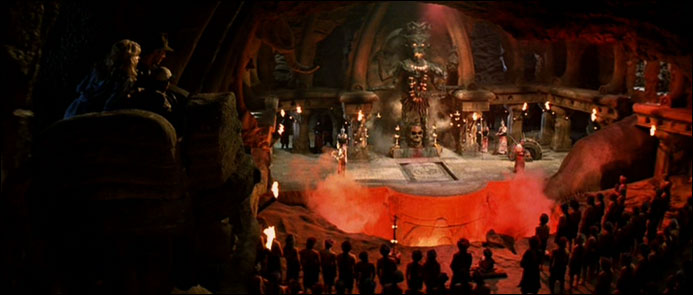As compared to the other Indiana Jones follow-ups, Indiana Jones and the Kingdom of the Crystal
Skull fosters an altogether different sensibility. While Indiana
Jones and the Temple of Doom and Indiana
Jones and the Last Crusade bear noticeable (however different) flaws,
they each have an aura that’s identifiable by various visual or narrative
elements. Kingdom of the
Crystal Skull is less accessible than those films, both in terms of its
relation to the broader lexicon of the series and as a unique chapter within
it. At the time of its release four years ago (and 19 years after Last Crusade), I
noted that it strained heavily to honor and amplify the nostalgia of
its own legend. Seeing the film again several years later, away from the
commercial hype, and in succession with its predecessors, I can more readily appreciate its layered compositions and busy thematic undercurrents. None of this changes the fact that this is coldest and least inviting of the four Jones affairs, a fact that only makes the film more intriguing than its reputation suggests.
The
nearly two-decade gap between Indiana
Jones and the Crystal Skull and its immediate predecessor may explain its heavy dose of reflexive mythology. Dating back to Raiders of the Lost Ark, Steven Spielberg has frequently framed Jones in silhouette, and here he takes the concept to new planes. After a
traditional introduction to Harrison Ford's hero (with his shadow cast against a military truck), an
encounter in plastic suburban platitudes resolves with
the obscured shape of Jones subjugated by an atomic mushroom cloud
encompassing the frame. Allusions to modern technology abound throughout the
otherwise historically fixated Crystal
Skull. David Koepp’s screenplay features long discussions about a Spanish
conquistadors and intra-dimensional space, while Spielberg only
shows a passing interest in Jones’ evolving family drama. Compared to Last Crusade, in particular, Crystal Skull is light in emotion and is
more concerned about how a hero like Jones finds a place—both physically and
symbolically—in a world increasingly defined by suspicion and the specter of
desolation.
These
elements play well against the atmospheres and jaunty rhythms of 1950's. (The brilliant opening title sequence offers a slice of American innocence, complete with Elvis Presley's "Hound Dog" playing over, before unveiling how its been infiltrated by KGB.) To boot, Spielberg’s
fluid visual senses are ever sharp. The action sequences are beautiful to look
at; every time you expect an edit the shot lingers and plays out the action in smooth fashion. The film falters in its loose grasp of conflict (translating to a general lack of tension) and its poor rendering of characters. Both Cate
Blanchett’s villain and Shia Labeouf’s “Jr.” are poorly realized, and the
tough bad guy henchman is cartoonishly excessive. These sour notes spotlight the film's curiously murky and overdone performances across the board. (Even the reliable Jim Broadbent does a lot of unnecessary shouting.) Additionally, while I confess
to loving the central conceit of the alien plot, it feels neither fully
complete nor fully integrated into the proceedings. This is ultimately what
sets Kingdom of the Crystal Skull
apart from its predecessors. It arguably has more going for itself with intricate thematic overtones and visual acuities but most of them are half-formed, resulting
in a film that—despite serving up a handful of great moments and several other good ones—lacks a definitive stamp.
Overall, I find Indiana Jones and the
Kingdom of the Crystal Skull the most difficult Jones film to penetrate. On
one hand, I see an uncommonly nuanced film for its type (as Keith Uhlich argued
in a wonderful piece several years ago), but I also understand why Jones devotees and casual fans alike felt distanced by it enough to
lump it with George Lucas’ shunned Star Wars prequel trilogy. (Steven Spielberg, 2008) **½






